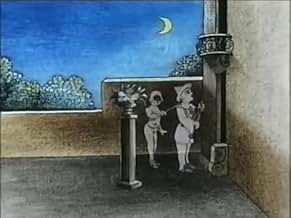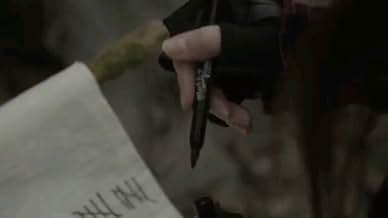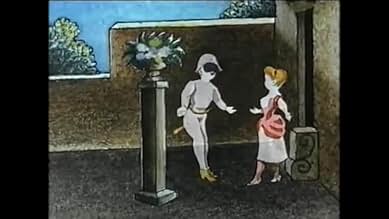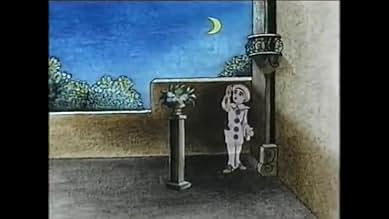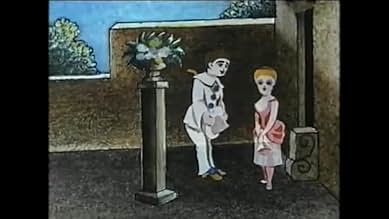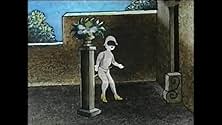ÉVALUATION IMDb
6,5/10
2,2 k
MA NOTE
Ajouter une intrigue dans votre langueOne night, Arlequin come to see his lover Colombine. But then Pierrot knocks at the door and Colombine and Arlequin hide. Pierrot starts singing but Arlequin scares him and the poor man goes... Tout lireOne night, Arlequin come to see his lover Colombine. But then Pierrot knocks at the door and Colombine and Arlequin hide. Pierrot starts singing but Arlequin scares him and the poor man goes away.One night, Arlequin come to see his lover Colombine. But then Pierrot knocks at the door and Colombine and Arlequin hide. Pierrot starts singing but Arlequin scares him and the poor man goes away.
- Director
- Writer
Avis en vedette
Pauvre Pierrot (1892)
This French film is considered one of the first animated movies ever made. From original reports it seems that the movie lasted longer than what's available in its current version but even at just four-minutes you can't help but be somewhat amazed at what great quality the film actually is. The plot is quite simple and deals with two men and a woman that they both want.
I will just leave the story at that but the main reason to watch this is for the beautiful animation. Now, it should go without saying but this movie was made in 1892 so one really shouldn't be expecting the work of Walt Disney. The film has a very fresh look to it and I must say that the colorful background is certainly the highlight.
This French film is considered one of the first animated movies ever made. From original reports it seems that the movie lasted longer than what's available in its current version but even at just four-minutes you can't help but be somewhat amazed at what great quality the film actually is. The plot is quite simple and deals with two men and a woman that they both want.
I will just leave the story at that but the main reason to watch this is for the beautiful animation. Now, it should go without saying but this movie was made in 1892 so one really shouldn't be expecting the work of Walt Disney. The film has a very fresh look to it and I must say that the colorful background is certainly the highlight.
Cute and strange; oh, and it's the first animated thing put to film... ever. Impressive for that alone, AND it has a story! It may not be too deep, and may be a little confusing (what's with the guy that comes out of nowhere and steals the guy's ukulele or whatever it is, is he a ghost?) But it does have a beginning, middle and sort of an end, maybe, arguably. For what this french animator was able to accomplish - and did I mention in COLOR no less - and for the simple fact that this is one of the major accomplishments of that century, to get something with images moving, albeit jerkily, I say you should check out all four minutes on YouTube or wherever silent film shorts are sold.
This might be fairly basic animation compared to today's 3D computer-generated spectaculars, but it is in its own way just as remarkable. Emile Reynaud developed many marvels like this, and operated some rather tricky mechanism to screen it. Sadly, Reynaud was not only something of a perfectionist who personally hand-painted every image of every film, he also only trusted himself to operate the screenings. and therefore stretched himself a little too far. He was hugely successful before the advent of movies, but was incapable of progressing and stands as a singular warning of the fate that befalls any business that fails to adapt to a changing market. The film has historical importance, and as a bitter and impoverished Reynaud destroyed most of his films years after the film industry had made his shows obsolete, it's something of a minor miracle that it still exists today.
It's cheating a little to list this as a film as strictly speaking it's not one, though its maker Émile Reynaud pushed pre-cinema technology as far as it could go to achieve an experience practically indistinguishable from that of watching a theatrical presentation of an animated cartoon film. His Théâtre Optique featured his Praxinoscope, a radical development of old-established animation toys like the Zoetrope. This used rotating faceted mirrors and lenses that could project a succession of hand-drawn images from a paper strip with sprocket holes, allowing much longer sequences of continuous action than the short loops hitherto used in such devices. These images were then superimposed on a static background projected from a conventional magic lantern slide, prefiguring later cel animation techniques in which the image is broken down into a succession of layers with the minimum of movement in each one. The exhibition was completed with live narration and music.
Some of Reynaud's original elements survive (others he later threw in the Seine) and their affinity with film is demonstrated by the ease with which they can be reconstructed on modern film or video. Pauvre Pierrot was the first such production and is among the most charming, a simple tale featuring the traditional characters Pierrot, Arlequin and Colombine acting out their ancient love triangle. Some reconstructions replicate the translucent, slightly ghostly quality the characters would have had at the time. Sadly Reynaud's work was overtaken by the arrival of the cinema proper and he died a poor and unhappy man.
Some of Reynaud's original elements survive (others he later threw in the Seine) and their affinity with film is demonstrated by the ease with which they can be reconstructed on modern film or video. Pauvre Pierrot was the first such production and is among the most charming, a simple tale featuring the traditional characters Pierrot, Arlequin and Colombine acting out their ancient love triangle. Some reconstructions replicate the translucent, slightly ghostly quality the characters would have had at the time. Sadly Reynaud's work was overtaken by the arrival of the cinema proper and he died a poor and unhappy man.
J. Stuart Blackton's 'Humorous Phases of Funny Faces (1906)' is generally held as the first animated film. Indeed, it was the first animated film made on motion-picture film, but such history is nevertheless unfair to Émile Reynaud, who, fourteen years earlier, was projecting moving animated images to delighted audiences. 'Pauvre Pierrot (1892)' is one of the director's few surviving works (most were, in a fit of frustration, discarded into the Seine by the director himself), and such a colourful and charming curio remains a delight to behold.
Reynaud animated each frame himself – 500 in total (36 metres long) – and extended the film to 12-15 minutes by personally manipulating the picture-bands during the projection. The story told is a simple one: Pierrot and Arlequin compete for the romantic attention of Colombine, a beautiful maiden. One potential suitor attempts to charm the good lady with a lute performance, but his competitor goes one better with a baton or sword of some sort.
Reynaud's moving picture show, billed as "Théâtre Optique" or "Pantomimes Lumineuses," included a triple-bill of three films: 'Pauvre Pierrot,' 'Un bon bock (1892),' and 'Le Clown et ses chiens (1892).' One contemporary newspaper reported that Reynaud "creates characters with expressions and movements so perfect that they give the complete illusion of life." The show was initially a great success, but, in 1918, Reynaud died a poor man. His delicate work, prone to rapid degradation, could not compete with the Lumière brothers' cinematograph, which depicted real-life, and not merely an animated approximation.
Reynaud animated each frame himself – 500 in total (36 metres long) – and extended the film to 12-15 minutes by personally manipulating the picture-bands during the projection. The story told is a simple one: Pierrot and Arlequin compete for the romantic attention of Colombine, a beautiful maiden. One potential suitor attempts to charm the good lady with a lute performance, but his competitor goes one better with a baton or sword of some sort.
Reynaud's moving picture show, billed as "Théâtre Optique" or "Pantomimes Lumineuses," included a triple-bill of three films: 'Pauvre Pierrot,' 'Un bon bock (1892),' and 'Le Clown et ses chiens (1892).' One contemporary newspaper reported that Reynaud "creates characters with expressions and movements so perfect that they give the complete illusion of life." The show was initially a great success, but, in 1918, Reynaud died a poor man. His delicate work, prone to rapid degradation, could not compete with the Lumière brothers' cinematograph, which depicted real-life, and not merely an animated approximation.
Le saviez-vous
- AnecdotesThe cartoon was hand drawn on hundreds of sheets of glass, each inlaid in a leather strips, through which a light was shone projecting the figures on a backdrop, as it was spooled from one reel to another, much like a modern film reel.
- ConnexionsFeatured in La magie Méliès (2002)
Meilleurs choix
Connectez-vous pour évaluer et surveiller les recommandations personnalisées
Détails
- Date de sortie
- Pays d’origine
- Langue
- Aussi connu sous le nom de
- Poor Pierrot
- Consultez plus de crédits d'entreprise sur IMDbPro
- Durée5 minutes
- Mixage
Contribuer à cette page
Suggérer une modification ou ajouter du contenu manquant

Lacune principale
By what name was Pauvre Pierrot (1892) officially released in Canada in English?
Répondre
